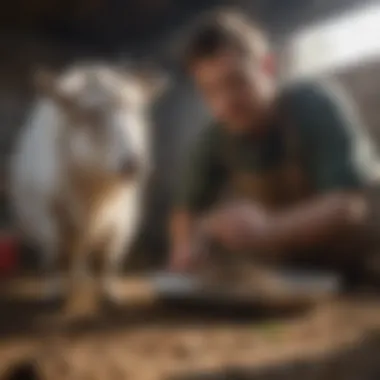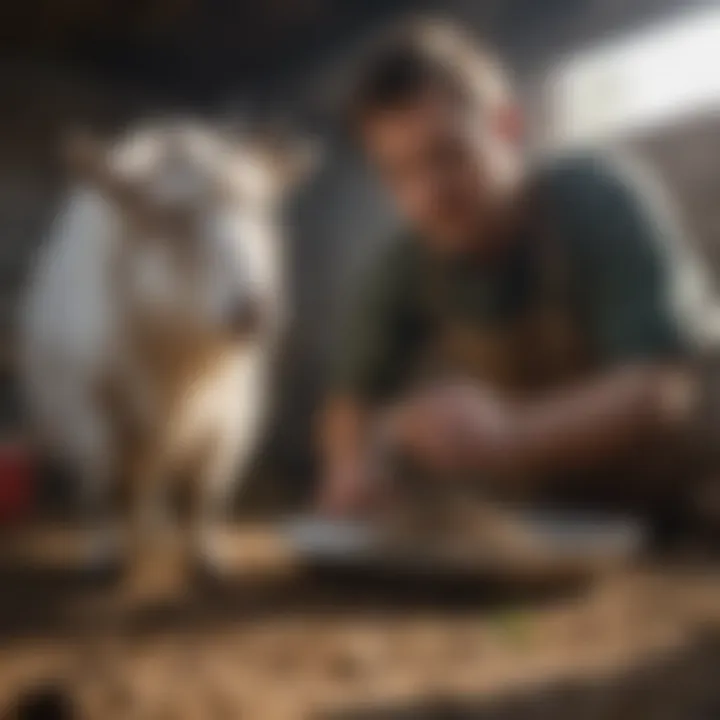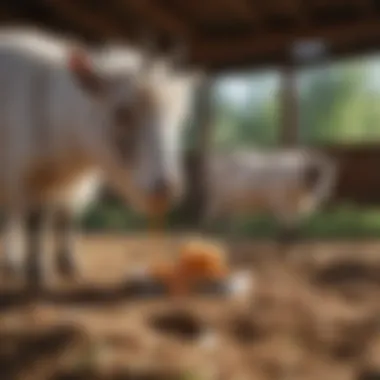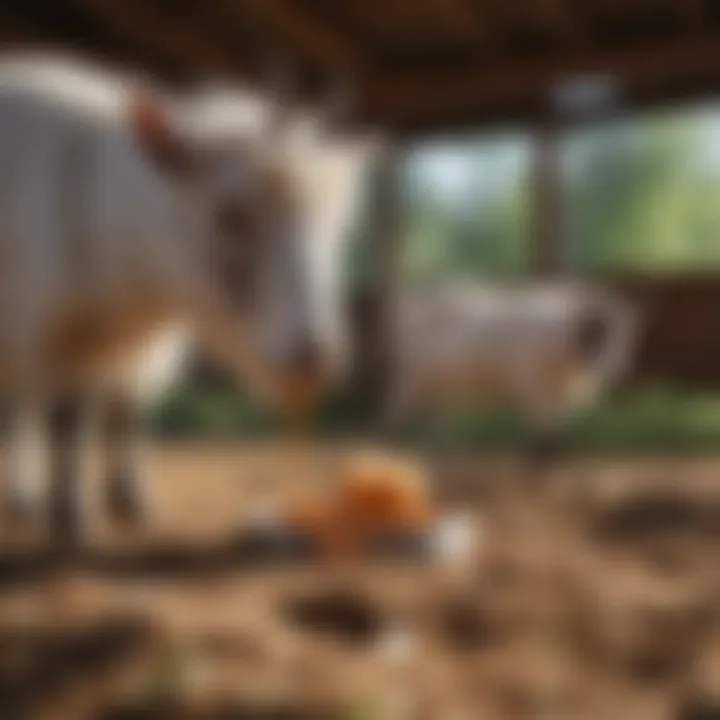Understanding Pygmy Goat Feeders: A Comprehensive Guide


Intro
Pygmy goats are a popular choice for many livestock enthusiasts due to their size, charm, and manageable care requirements. However, providing proper nutrition is critical for their health and well-being. Feeders play an essential role in this process by ensuring that these goats have access to the right amount of food, while also minimizing waste. Understanding the unique requirements for pygmy goat feeders can enhance feeding practices and overall goat husbandry.
This comprehensive guide aims to explore various feeder designs, feeding techniques, and the maintenance of these systems. It also focuses on common issues farmers face and potential solutions to improve the feeding process for pygmy goats.
Overview of the Topic
Definition and Importance
Pygmy goat feeders are specialized feeding apparatus designed to serve the nutritional needs of pygmy goats. Their design often varies depending on specific requirements such as the type of feed, the number of goats being fed, and environmental conditions.
Proper feeding ensures that pygmy goats receive essential nutrients, promoting healthy growth and productivity. Moreover, the right feeder can reduce waste and prevent feed contamination, leading to a healthier overall environment for the goats.
Current Trends
The market for goat feeders continues to evolve, with trends leaning towards more automated and efficient designs. Innovations include self-feeding systems and feeders designed to limit waste. Additionally, many farmers are incorporating materials that are easier to clean and maintain, recognizing the importance of hygiene in livestock care.
Key Techniques and Practices
Step-by-Step Guide
To effectively choose and utilize pygmy goat feeders, consider the following points:
- Assess Your Needs: Determine the number of goats and the type of feed you will be using.
- Choose the Right Style: Options include trough feeders, hay racks, and grain bins. Each has its advantages.
- Evaluate Location: Place feeders in areas that provide shelter and are easy to clean.
- Monitor Feed Intake: Regularly check the amount of feed consumed to adjust feeding as necessary.
Tools and Equipment Needed
Gathering the following tools can help manage pygmy goat feeding:
- Quality Feeders: Invest in durable and appropriately-sized feeders based on your goats' needs.
- Cleaning Supplies: Tools to clean and maintain the feeders.
- Measuring Tools: To measure feed portions accurately.
Challenges and Solutions
Common Obstacles
Farmers may face several challenges when feeding pygmy goats:
- Feed Waste: Goats may waste food if feeders are not designed to minimize access.
- Contaminated Feed: Feed can easily get wet or dirty, leading to health concerns.
- Competition for Food: In multi-goat systems, some goats may dominate feeding spots.
Innovative Solutions
Possible solutions include:
- Design Modifications: Create feeders that ensure access while minimizing waste.
- Regular Cleaning Schedule: Establish a routine to keep feeders clean and free from mold.
- Scatter Feeding: In cases of competition, consider scattering feed in multiple locations to give all goats access.
"Understanding the feeding dynamics of pygmy goats is essential for their health and your farm's success."
Keeping these considerations in mind will help enhance the feeding process, ensuring that pygmy goats remain healthy and productive.
Prologue to Pygmy Goat Feeders
Understanding feeders for pygmy goats is essential for anyone involved in their care. These small animals require a specific diet to thrive, and the right feeder can significantly impact their health and well-being. Pygmy goats, known for their friendly nature and compact size, are a popular choice among farmers and hobbyists. However, their feeding needs are often overlooked.
A well-designed feeder ensures that these goats receive an adequate amount of food while minimizing waste. It also helps in preventing common health issues associated with improper feeding methods.
Defining Pygmy Goats
Pygmy goats, originally from West Africa, are characterized by their small stature, with adults usually weighing between 50 to 100 pounds. They have a robust build and are known for their playful and curious behavior. Being ruminants, they have a specialized digestive system that allows them to efficiently break down fibrous plant materials. This trait makes them unique in their feeding requirements compared to larger goat breeds.
Understanding the physical characteristics and behavioral aspects of pygmy goats is vital for effective management. Farmers need to be aware of their social nature; pygmy goats thrive when kept in groups. This social behavior can influence their feeding habits, as they often interact during mealtime.
Importance of Proper Feeding
Proper feeding is critical for sustaining pygmy goats’ health and ensuring they meet growth and production goals. A balanced diet rich in nutrients promotes better growth rates, stronger immune systems, and overall vigor. The right feeder plays a significant role in achieving these dietary requirements.
By utilizing appropriate feeding practices, farmers can reduce waste and prevent overfeeding, which leads to obesity and related health issues in pygmy goats.
Key Benefits of Proper Feeding Practices Include:
- Enhanced Growth Rates: Ensures goats reach desirable weights in a healthy time frame.
- Healthier Animals: Proper nutrition can prevent diseases and promote longevity.
- Improved Reproductive Success: A well-nourished goat exhibits better fertility and kid survivability.
"A balanced diet is the foundation of effective pygmy goat husbandry."


To sum up, understanding pygmy goat feeders encompasses not only the selection of the right feeder but also recognizing the unique needs of these animals. This understanding is crucial for maintaining their health and productivity.
Types of Pygmy Goat Feeders
The choice of feeding equipment impacts pygmy goats' health and well-being. Proper feeders facilitate effective feeding while minimizing waste and stress. Understanding the different types of pygmy goat feeders is essential for ensuring that goats receive a balanced diet. Each type of feeder offers unique benefits that cater to specific needs. Knowing the variations can help farmers select the most suitable options for their animals.
Hanging Feeders
Hanging feeders are an effective solution for providing food to pygmy goats. These feeders can be suspended from fences or posts, which helps keep feed off the ground. By minimizing ground exposure, these feeders reduce the risk of contamination from mud or feces, ensuring that goats eat clean feed. They also limit waste, as hungry goats learn to eat from a designated spot without scattering food.
These feeders are usually adjustable, allowing farmers to set the height according to the goats’ growth stages. A hanging feeder can accommodate multiple goats, making it economical for herds. Choosing a feeder made of durable material, such as metal or high-quality plastic, is important for long-lasting use.
Stationary Feeders
Stationary feeders are fixed structures designed to remain in one location. These can be large enough to serve multiple goats at once and are ideal for farms with a dedicated feeding area. The stable design allows for easy refilling, which can be done less frequently compared to smaller feeders.
These feeders can be open-sided or covered, providing shelter for the feed from rain or sun.
Key considerations when selecting a stationary feeder include:
- Size: Ensure it is large enough for the number of goats you have.
- Material: Look for weather-resistant options for longevity.
- Accessibility: Ensure goats can reach their feed comfortably.
Portable Feeders
Portable feeders offer flexibility in pasture management. This type allows farmers to relocate feeding stations easily as goats deplete forage in certain areas. A portable feeder is especially useful for rotational grazing, which helps maintain pasture health. These feeders are typically lightweight and can be moved by one person.
Farmers might opt for designs with wheels for easier maneuverability. The advantages of portable feeders include:
- Versatility: Move to fresh grazing spots based on needs.
- Ease of Use: Light and convenient to transport.
- Reduction of Overgrazing: Help manage feeding in various locations to prevent damaging pastures.
Design Considerations for Feeders
When constructing feeders for pygmy goats, several design considerations significantly influence their effectiveness, durability, and usability. Understanding these considerations is crucial for farmers and enthusiasts who wish to optimize their feeding practices. Proper design affects the overall feeding experience for both the goats and the caregivers, enhancing animal welfare and streamlining daily operations.
Size and Capacity
The size and capacity of a feeder must align with the number of pygmy goats being fed. Each goat requires a certain amount of food for proper nutrition. A feeder that is too small may force goats to compete for limited access to feed, leading to stress and potential injuries. Ideally, farmers should calculate the daily feed requirements for their goats, which typically range from two to four pounds per adult a day, depending on age, weight, and activity level.
A well-sized feeder accommodates multiple goats at once, providing enough space for them to eat comfortably. This setup minimizes competition and promotes healthier eating habits. Additionally, you should design feeders that can adapt to the growth of the herd, if you plan to expand in the future.
Material Choices
Material selection is equally important. Feeders made from durable, non-toxic materials ensure safe feeding and reduce the risk of injury. Common materials include wood, metal, and heavy-duty plastic. Each comes with its advantages. For instance, wood offers a more traditional look but requires regular treatment to avoid rot. Metal is robust and resistant to chewing, but it can be heavy and may rust over time if not properly coated. Plastic feeders are lightweight and easier to clean, but may not withstand the test of time as well as heavier materials.
Furthermore, the choice of materials should consider ease of maintenance. Feeders that are easy to clean enhance hygiene and reduce the risk of disease. Consider using smooth surfaces that can be washed and sanitized regularly.
Weather Resistance
As pygmy goats are often raised in varying climatic conditions, weather resistance of feeders is a crucial design aspect. Feeders exposed to rain, snow, or extreme sun must be made from materials that can withstand the elements without deteriorating. If using wooden feeders, selecting treated wood can prolong their lifespan, as untreated wood may warp, splinter, or rot.
Additionally, providing roofs or covers for feeders helps to protect the feed from becoming wet or spoiled. This consideration not only preserves the feed but also encourages goats to eat more willingly in inclement weather.
In summary, thoughtful design considerations regarding size, material choices, and weather resistance greatly impact the effectiveness of pygmy goat feeders. Each element plays a role in ensuring the health and well-being of the goats while simplifying the feeding process for caregivers.
"A well-designed feeder can greatly enhance the welfare of pygmy goats by promoting a calm and nutritious feeding environment."
For additional guidance, consider checking relevant resources, such as Wikipedia, Britannica, or community discussions on platforms like Reddit and Facebook.
Understanding these design factors ensures that pygmy goats receive the best possible care, making it easier to maintain their health and productivity.
Feeding Practices for Pygmy Goats
Feeding practices for pygmy goats are an essential aspect of their overall husbandry. Proper feeding ensures that these animals receive the necessary nutrients for their health and productivity. It also impacts their growth, reproduction, and general well-being. In this section, we will discuss key elements of a suitable diet, how often to feed these goats, and the importance of monitoring their feed intake.
Balanced Diet Requirements
Pygmy goats require a balanced diet that fulfills their nutritional needs. This includes a mix of hay, grains, and minerals. Hay should be the primary source of forage. High-quality hay like timothy or orchard grass is preferred. It is essential to avoid moldy or dusty hay, as it can cause respiratory issues.
Grains can supplement their diet but should not dominate it. Grains such as oats and barley provide energy but can lead to obesity if fed excessively. Additionally, minerals and vitamins are crucial. A mineral block designed for goats should be available at all times.
A balanced diet enhances the health and vitality of pygmy goats and supports their growth and reproduction.
Frequency of Feeding


Feeding frequency is another critical aspect. Pygmy goats thrive on consistent feeding schedules. Generally, they should be fed two to three times daily. This helps in digesting food properly and avoids excess weight gain. In the morning and evening, grain can be given, while hay availability should be constant.
During extremely hot weather, adjusting the feeding times may be necessary. Feeding during cooler parts of the day can enhance their comfort. Seasonal changes might also affect their appetite, so monitoring their intake is essential.
Monitoring Feed Intake
Monitoring feed intake is vital to ensure pygmy goats maintain a healthy weight and receive adequate nutrition. It is wise to observe their eating behavior regularly. Make note if they seem less interested in food. This could signal health issues or stress.
Regular weighing can help assess if goats are gaining or losing weight unexpectedly. If weight loss occurs, it can be due to illness, parasites, or inadequate diet.
In summary, feeding practices must be systematic and adaptable based on the goat's age, health, and environmental conditions. Proper diet and monitoring can lead to healthier, more productive pygmy goats.
The Benefits of Using Specialized Feeders
Using specialized feeders for pygmy goats comes with numerous advantages that can enhance both the dietary experience of the goats and the ease of care for the farmer. This section focuses on three key benefits: reduced waste, improved health, and convenience for farmers. Each of these factors plays a crucial role in the overall success of pygmy goat husbandry.
Reduced Waste
One of the most significant advantages of specialized feeders is that they can dramatically reduce feed waste. Such feeders are designed to minimize the chance of spillage and contamination. For instance, well-constructed hanging feeders ensure that food remains dry and is not trampled by the goats. This aspect is critical because uneaten feed can attract pests and lead to further issues, both for herd health and maintenance.
Think about the costs associated with feed. When animals waste food, those costs pile up. Farmers can choose feeders with designs that encourage goats to eat more efficiently, which also translates into long-term financial savings. Additionally, feeders that restrict access to hay can prevent playful pygmy goats from tossing their food around, thereby keeping feeding areas tidy.
"Investing in good-quality feeders can save farmers time and money in the long run."
Improved Health
The health of pygmy goats can significantly benefit from the use of specialized feeders. Proper feeders promote better digestion and nutrition intake. They can be designed to accommodate specific dietary needs, such as offering enough space for each goat to eat comfortably. This design can help reduce competition among goats, decreasing stress levels during feeding times.
Furthermore, certain feeders can be structured to provide minerals and vitamins in a controlled manner. This specificity ensures that goats get all essential nutrients without excessive consumption of any one type of food. Farmers can therefore monitor individual goats’ needs better and adapt their feeding practices accordingly.
Convenience for Farmers
From a practical standpoint, specialized feeders offer convenience that traditional feeding methods simply cannot match. They often come with features that streamline the feeding process, such as easy access for refilling. Farmers can spend less time managing the feeding process and more time focusing on other aspects of goat care.
Additionally, specialized feeders can be mobile. This mobility allows farmers to change feeding areas, which can lead to better pasture management. For example, rotating the location of feeders can help prevent overgrazing in one area and ensure more uniform pasture use.
Overall, the incorporation of specialized feeders into pygmy goat husbandry not only benefits the goats but also simplifies management tasks for farmers. The resulting environment is conducive to healthier goats and more efficient farming practices.
Maintaining Pygmy Goat Feeders
Maintaining pygmy goat feeders is an essential aspect of proper goat husbandry. Proper maintenance ensures that the feeders remain functional and safe, supporting the health and well-being of the goats. Regular upkeep can also extend the life of the feeders, making it a cost-effective practice. Key elements to consider include cleaning and sanitizing, inspecting for wear and tear, and seasonal maintenance tasks. Each of these aspects contributes to the overall goal of providing consistent and hygienic feeding conditions for pygmy goats.
Cleaning and Sanitizing
Cleaning and sanitizing pygmy goat feeders is critical to prevent the buildup of bacteria, mold, or other pathogens that could harm the goats. Feeders should be cleaned regularly, especially after emptying and refilling them. This process often involves the following steps:
- Remove Old Feed: Dispose of any leftover feed that can spoil.
- Wash with Soap: Use warm water and mild soap to scrub the inside and outside of the feeder.
- Sanitize: After washing, apply a safe sanitizing solution, such as a diluted vinegar solution. This step helps to eliminate any harmful microorganisms.
- Rinse Thoroughly: Always rinse the feeder well to remove any soap or sanitizer residue before adding new feed.
This routine is essential not only for hygiene but also for encouraging healthy eating habits in pygmy goats. Goats are naturally curious and tend to inspect their environment. A clean feeder can prevent them from developing aversions to feeding areas.
Inspecting for Wear and Tear
Regular inspection for wear and tear is vital to maintain the integrity of pygmy goat feeders. Cracks, sharp edges, or loose components can be hazardous. During inspections, consider these factors:
- Structural Integrity: Check if the feeder is stable. Look for cracks or bends in the material.
- Safety Hazards: Ensure that there are no sharp edges that could injure the goats.
- Hinges and Fastenings: Look at any joints or connections, ensuring they function properly. Replace them if they are loose or broken.
- Surface Condition: Monitor for peeling paint or rust on metal feeders that could come into contact with feed.
Being proactive in addressing these issues can prevent larger problems down the road. If a feeder is deemed unsafe, it should be repaired or replaced promptly.
Seasonal Maintenance Tasks
Seasonal changes can impact the functionality of pygmy goat feeders. It is important to adjust maintenance routines accordingly, with specific tasks for each season:
Spring:
- Inspect for damage from winter weather.
- Perform a thorough clean-up after snow and ice have melted.
Summer:
- Check for any insect infestations that might have developed.
- Ensure feeders are adequately shaded to prevent feed from spoiling in the heat.
Fall:
- Prepare feeders for the winter months by reinforcing structures and securing them against storms.
- Conduct a final deep clean before winter sets in.


Winter:
- Monitor for ice buildup around feeders, which can deter goats from eating.
- Ensure that the feeders remain accessible despite snow accumulation.
Maintaining pygmy goat feeders through these steps enhances their functionality and supports the overall health of the goats. A well-maintained feeding environment is a fundamental aspect of successful goat husbandry.
Common Issues with Pygmy Goat Feeders
In the realm of pygmy goat husbandry, feeders play a crucial role in ensuring that these small livestock receive their nutrition effectively. However, like any tool, pygmy goat feeders can present common issues that if not addressed, can lead to larger problems. Understanding these issues is essential for farmers and enthusiasts alike. This section explores two significant concerns: design flaws leading to spillage and predator risks that can threaten the safety of the goats.
Design Flaws Leading to Spillage
One of the primary issues with pygmy goat feeders is design flaws that can cause feed spillage. When feeders are not constructed properly, they can become inefficient. Feed can easily spill out, leading to waste. This also means that goats may not get the necessary food, making them prone to nutritional deficiencies.
Several factors lead to this spillage problem:
- Inadequate Height and Angles: Feeders that are too low or lack proper angular design may allow goats to easily access and knock over the feed.
- Open designs: Feeders with open tops can lead to food being wasted as it falls out when fed upon by the goats.
- Material Choices: Some materials do not contain the feed well. If the feeder is made of slippery surfaces, feed can slide out easily.
To counter these issues, it’s important to focus on proper construction. Designing feeders with appropriate heights, covers, and using rough materials can minimize spillage. Regular evaluation of feeders can also help identify problems early on and reduce feed waste.
Predator Risks
Another pressing issue involves predator risks associated with pygmy goat feeders. When feeders are located in vulnerable areas, they can attract not only goats but also predators. Animals like raccoons, coyotes, and even domestic dogs can pose threats.
Considering predator risks is important due to several reasons:
- Safety of Goats: Goats may become targets if the feeding area is not secure. A well-placed feeder minimizes the chances of predators striking.
- Feed Security: Predators can steal feed, which further leads to nutritional shortages for the goats.
- Stress for the Goats: The presence of potential threats decreases the comfort level of pygmy goats, leading to increased stress which is not beneficial for their health.
To mitigate these risks, feeders should be placed in secure areas. Creating enclosures or using feeding devices that deter predators can be helpful. Monitoring goat behavior during feeding times can also provide insights into whether any predator threats exist in that area.
Effective feeder design and placement is crucial to ensure that pygmy goats are fed in a safe, efficient manner. Regularly assessing feeders for common issues is vital for maximizing health and well-being.
Addressing these common issues with pygmy goat feeders not only improves feeding practices but also enhances the overall management of pygmy goats. By minimizing spillage and securing feed from predators, farmers can ensure their livestock are properly nourished and protected.
Customizing Feeders for Specific Needs
When managing pygmy goats, it is essential to customize feeders to suit their specific needs. Each goat is unique, displaying different behaviors, dietary preferences, and health statuses. By tailoring feeder designs and functionalities, you can enhance their feeding experience, ensuring that goats receive adequate nutrition while minimizing waste and promoting their overall welfare.
Accommodating Different Ages
Pygmy goats come in various ages, each with its own dietary requirements and physical capabilities. Young kids have different nutritional needs compared to adults.
- For Kids: Young goats need a balanced diet rich in energy and protein to support their growth. A feeder designed for kids should be lower to the ground, making it accessible. Additionally, these feeders can feature smaller compartments to prevent larger portions of food from being wasted.
- For Adults: Adult pygmy goats require more fibrous materials in their diet. Feeders for adult goats can be higher off the ground, potentially designed with larger openings to accommodate hay and grain.
Benefits of Age-Specific Feeders:
- Reduces choking hazards for kids.
- Encourages proper eating habits, especially for younger goats.
- Attracts adults to feed efficiently without wasting food.
Adjustments for Health Concerns
Health concerns must also factor into the customization of pygmy goat feeders. Some goats may suffer from digestive issues or other health problems that necessitate careful consideration in their feeding setup.
- For Goats with Digestive Issues: If a goat has been diagnosed with conditions like bloat or other gastrointestinal disorders, a slow feeder is recommended. This type of feeder regulates the rate at which the goat consumes food. It helps reduce overeating, thus preventing health complications.
- For Obesity or Weight Management: Custom feeders can assist in managing a pygmy goat's weight. Feeders that portion control the amount of feed can help prevent weight gain. Additionally, these feeders may be designed to allow only certain foods, promoting healthier eating habits.
Considerations for Health Adjustable Feeders:
- Materials should be non-toxic and easy to clean.
- Design can support specific dietary needs, for example, using various compartments.
- Feeder placement can ensure goats with mobility issues can access food easily.
In summary, customizing pygmy goat feeders is not just about feeding convenience; it is crucial for ensuring that each goat’s individual needs are met effectively. Properly designed feeders can promote better health outcomes while enhancing the feeding experience.
Culmination
The conclusion of this article serves to encpmpass the key insights gained through the exploration of pygmy goat feeders. It is essential to recognize the significance of appropriate feeding practices, as these directly contribute to the overall well-being and productivity of pygmy goats. Farmers and enthusiasts should prioritize understanding how various feeders function and their role in minimizing waste and enhancing health.
Furthermore, maintaining these feeders and adapting them to meet specific needs ensures that pygmy goats receive nutritionally balanced meals in an effective manner.
Summary of Key Points
- Types of Feeders: Various feeder types are available—hanging, stationary, and portable—each catering to unique farm layouts and goat behaviors.
- Design Considerations: The design should account for size, material, and resistance to weather elements, ensuring durability and ease of cleaning.
- Feeding Practices: A balanced diet and regular monitoring of feed intake are critical to the health of pygmy goats.
- Maintenance: Regular cleaning and inspection can prevent issues that could lead to health risks for the goats or damage to the feeders.
- Customization: Feeders can be customized based on age and health conditions to cater to each goat’s specific needs.
Future Considerations
As agriculture continues to evolve, so do the methods and tools used in goat husbandry. It is imperative for farmers and goat enthusiasts to stay informed about new research and developments in feeding practices and equipment technology.
- Innovation in feeder design: Looking for advancements that could improve functionality and efficiency.
- Sustainability Practices: Incorporating eco-friendly materials and practices into feeder design can have positive long-term implications for goat farming.
- Regular Training: Engaging in workshops and training sessions can help farmers keep their skills updated, ensuring they are equipped to implement best practices.
"Proper understanding and maintenance of pygmy goat feeders is vital, impacting goats' health and overall farm efficiency."
With these considerations in mind, stakeholders in the pygmy goat sector can make informed decisions that enhance their feeding strategies and improve the reproductive and mellifluous qualities of their herd.



